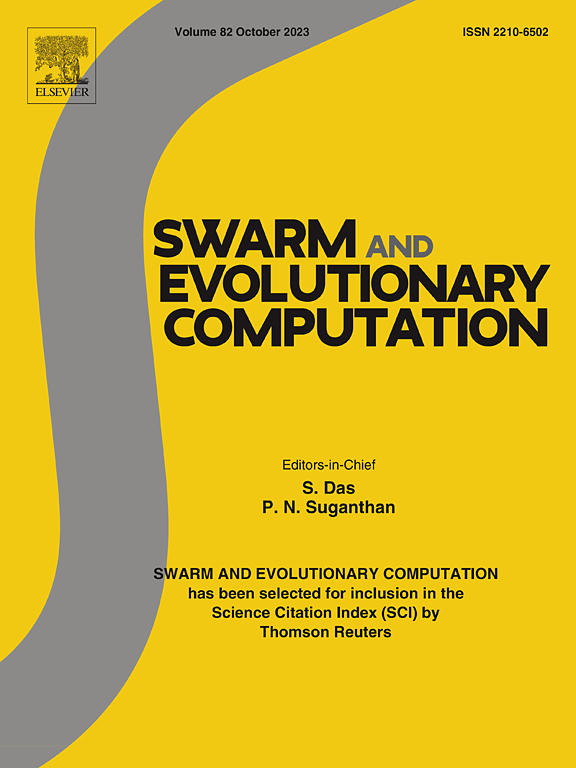Alternating curvature-driven evolutionary genetic algorithm for cable insulation thickness measurement
IF 8.5
1区 计算机科学
Q1 COMPUTER SCIENCE, ARTIFICIAL INTELLIGENCE
引用次数: 0
Abstract
Accurate insulation thickness measurement in industrial cables presents a critical yet challenging optimization problem, characterized by an extremely large solution space and stringent requirements for sub-millimeter precision under real-time constraints. Traditional computer vision approaches struggle with computational complexity when processing irregular cross-sections, while conventional evolutionary algorithms exhibit poor convergence characteristics due to the non-convex search landscape. To address these dual challenges, we propose an Alternating Curvature-Driven Genetic Algorithm (ACD-GA) that innovatively integrates geometric prior knowledge with evolutionary computing. Our key advancement lies in establishing a multi-scale curvature gene information database that synergizes differential geometry with adaptive genetic operators. This hybrid architecture features three core innovations: (1) Adaptive generation of initial populations based on multi-scale curvature characteristics to ensure gene quality and diversity; (2) Alternating crossover-mutation operations guided by curvature information to accelerate solution convergence; (3) A population renewal mechanism combining crossover-mutation with original populations and post-selection updates to preserve high-quality genes. Experiments on both regular and irregular IEC standard specimens demonstrate the superiority of ACD-GA in terms of accuracy, repeatability, and convergence efficiency. Compared with traditional manual inspection and fitted ray methods, ACD-GA reduces the average detection time by over 95.8%, decreases the minimum insulation thickness deviation by more than 89.3%, and significantly improves measurement repeatability. When compared with classical evolutionary algorithms (GA, PSO, ACO, SA, DE) and the latest intelligent methods (PSOCO, HPDE, TDE), ACD-GA achieves reductions of 21.1%–86.7% in minimum thickness deviation and up to 88.5% in repeatability, while maintaining comparable detection efficiency.
交替曲率驱动的电缆绝缘厚度测量进化遗传算法
工业电缆绝缘厚度的精确测量是一个关键而又具有挑战性的优化问题,其特点是求解空间非常大,并且在实时约束下对亚毫米精度的要求非常严格。传统的计算机视觉方法在处理不规则截面时计算量大,而传统的进化算法由于非凸搜索环境而表现出较差的收敛特性。为了解决这些双重挑战,我们提出了一种交替曲率驱动遗传算法(ACD-GA),该算法创新地将几何先验知识与进化计算相结合。本研究的主要进展是建立了一个将微分几何与自适应遗传算子相结合的多尺度曲率基因信息数据库。该混合结构具有三个核心创新:(1)基于多尺度曲率特征自适应生成初始种群,保证基因质量和多样性;(2)以曲率信息为导向的交替交叉突变运算,加速解的收敛;(3)种群更新机制结合了与原种群的交叉突变和选择后更新以保留优质基因。在规则和非规则IEC标准试样上的实验证明了ACD-GA在精度、重复性和收敛效率方面的优越性。与传统的人工检测和拟合射线检测方法相比,ACD-GA平均检测时间缩短95.8%以上,最小绝缘厚度偏差减少89.3%以上,显著提高了测量的重复性。与经典进化算法(GA、PSO、ACO、SA、DE)和最新智能算法(PSOCO、HPDE、TDE)相比,ACD-GA在保持相当检测效率的同时,最小厚度偏差降低21.1% ~ 86.7%,可重复性高达88.5%。
本文章由计算机程序翻译,如有差异,请以英文原文为准。
求助全文
约1分钟内获得全文
求助全文
来源期刊

Swarm and Evolutionary Computation
COMPUTER SCIENCE, ARTIFICIAL INTELLIGENCEC-COMPUTER SCIENCE, THEORY & METHODS
CiteScore
16.00
自引率
12.00%
发文量
169
期刊介绍:
Swarm and Evolutionary Computation is a pioneering peer-reviewed journal focused on the latest research and advancements in nature-inspired intelligent computation using swarm and evolutionary algorithms. It covers theoretical, experimental, and practical aspects of these paradigms and their hybrids, promoting interdisciplinary research. The journal prioritizes the publication of high-quality, original articles that push the boundaries of evolutionary computation and swarm intelligence. Additionally, it welcomes survey papers on current topics and novel applications. Topics of interest include but are not limited to: Genetic Algorithms, and Genetic Programming, Evolution Strategies, and Evolutionary Programming, Differential Evolution, Artificial Immune Systems, Particle Swarms, Ant Colony, Bacterial Foraging, Artificial Bees, Fireflies Algorithm, Harmony Search, Artificial Life, Digital Organisms, Estimation of Distribution Algorithms, Stochastic Diffusion Search, Quantum Computing, Nano Computing, Membrane Computing, Human-centric Computing, Hybridization of Algorithms, Memetic Computing, Autonomic Computing, Self-organizing systems, Combinatorial, Discrete, Binary, Constrained, Multi-objective, Multi-modal, Dynamic, and Large-scale Optimization.
 求助内容:
求助内容: 应助结果提醒方式:
应助结果提醒方式:


